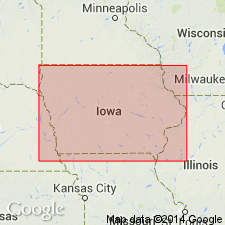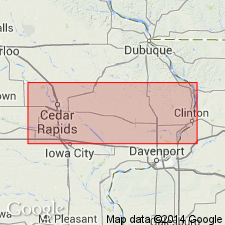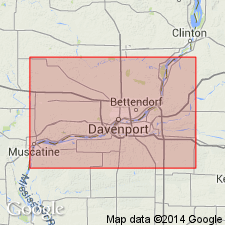
- Usage in publication:
-
- Welton Member
- Modifications:
-
- Named
- Dominant lithology:
-
- Dolomite
- AAPG geologic province:
-
- Iowa shelf
Summary:
Hopkinton Dolomite, previously divided on the basis of paleontologic units, is here divided into lithologic members to facilitate interregional correlations based on sea-level curves. Rocks formerly called the CYRTIA beds of the Hopkinton are here named the Welton Member in eastern IA. Consists of tan, poorly bedded, very finely crystalline dolomite containing a diversity of brachiopods, crinoids, trilobites, and bryozoans. Overlies both the patch-reef and inter-reef facies of the Johns Creek Quarry Member and underlies the Buck Creek Quarry Member, both new members of the Hopkinton. Thickness is 12.5 m or more. Age is Early Silurian (Llandoverian, Telychian).
Source: GNU records (USGS DDS-6; Reston GNULEX).

- Usage in publication:
-
- Welton Member
- Modifications:
-
- Revised
- AAPG geologic province:
-
- Iowa shelf
Summary:
The Johns Creek Quarry, Welton, and Buck Creek Quarry Members, all new names of Johnson (1983), are here reassigned from the upper part of the Hopkinton Dolomite to the lower part of the Scotch Grove Formation (new name). The Scotch Grove is defined between the Hopkinton and the Gower Formation for the purpose of preserving the original definitions of these two units.
Source: GNU records (USGS DDS-6; Reston GNULEX).

- Usage in publication:
-
- Welton Member
- Modifications:
-
- Areal extent
- AAPG geologic province:
-
- Wisconsin arch
- Iowa shelf
Summary:
According to author, one of his primary aims in this report is to strongly encourage adoption of IA nomenclature in adjacent IL. The only major change is the incorporation of the Sweeney and Marcus as members within the Hopkinton and replacement of the Racine with upper members of the Hopkinton, the Scotch Grove Formation, and the Gower Formation. The Scotch Grove occurs entirely in the subsurface in the Quad Cities area. Members of the Scotch Grove recognized in the eastern IA and western IL Quad Cities area are the basal Johns Creek Quarry Member, the Welton Member (which composes the bulk of the formation), and the Waubeek Member. The Welton is a finely fossil-moldic (primarily crinoidal) dolomite. Welton strata locally extend to the top of the Scotch Grove in the study area.
Source: GNU records (USGS DDS-6; Reston GNULEX).
For more information, please contact Nancy Stamm, Geologic Names Committee Secretary.
Asterisk (*) indicates published by U.S. Geological Survey authors.
"No current usage" (†) implies that a name has been abandoned or has fallen into disuse. Former usage and, if known, replacement name given in parentheses ( ).
Slash (/) indicates name conflicts with nomenclatural guidelines (CSN, 1933; ACSN, 1961, 1970; NACSN, 1983, 2005, 2021). May be explained within brackets ([ ]).

